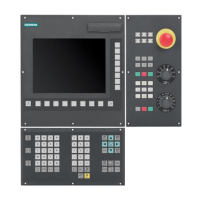Tool: Compensation and Monitoring (W1)
25.4 Tool monitoring
Turning, Milling, Nibbling
428 Function Manual, 11/2012, 6FC5397-1CP10-5BA0
Setpoint update with RESETMON( )
The RESETMON(state, t, d, mon) function sets the actual value to the setpoint:
● For all cutting edges or only for a specific cutting edge of a specific tool
● For all monitoring types or only for a specific monitoring type.
Transfer parameters:
INT state Status of the command execution:
= 0 Successful execution
= -1 The cutting edge with the specified D number d does not exist.
= -2 The tool with the specified T number t does not exist.
= -3 The specified tool t does not have a defined monitoring function.
= -4 The monitoring function is not activated, i.e. the command is not executed.
INT t Internal T number:
= 0 For all tools
<> 0 For this tool (t < 0: Absolute value generation |t|)
INT d
Optional:
D number of the tool with the number t:
> 0 For this D number
= 0 All cutting edges of the tool t
INT mon
Optional:
bit-encoded parameters for the monitoring type (values like
$TC_TP9):
= 1 Tool life
= 2 Quantity
= 0 All actual values of the monitoring functions active for tool t are set to their
setpoints.
Note
Please note:
• RESETMON( ) is not active if the interface signal "Program test active" is set.
• The variable for the state feedback must be defined at the beginning of the program using
a DEF statement: DEF INT state
You can also define a different name for the variable (instead of state, with a maximum of
15 characters, beginning with 2 letters). The variable is only available in the program in
which it was defined.
The same applies for mon. If a value is required at all it can also be directly transferred as
a number (1 or 2).

